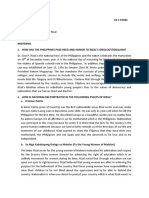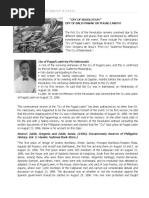0 ratings0% found this document useful (0 votes)
552 viewsBy: Ena Jaydine Pasamonte Cydnie Khaile Ismael
By: Ena Jaydine Pasamonte Cydnie Khaile Ismael
Uploaded by
XeXe DAY6This document summarizes and compares two paintings titled "Ina ng Lahi" by Jose P. Alcantara and Antonio Dumlao. It provides background information on the artists, including that Alcantara was a renowned sculptor and Dumlao was a noted muralist. It also gives details about each painting such as the medium used, prizes won, and locations currently housed. Finally, it analyzes symbolic mentifacts of the works in depicting Filipina women during Spanish colonization.
Copyright:
© All Rights Reserved
Available Formats
Download as PDF, TXT or read online from Scribd
By: Ena Jaydine Pasamonte Cydnie Khaile Ismael
By: Ena Jaydine Pasamonte Cydnie Khaile Ismael
Uploaded by
XeXe DAY60 ratings0% found this document useful (0 votes)
552 views9 pagesThis document summarizes and compares two paintings titled "Ina ng Lahi" by Jose P. Alcantara and Antonio Dumlao. It provides background information on the artists, including that Alcantara was a renowned sculptor and Dumlao was a noted muralist. It also gives details about each painting such as the medium used, prizes won, and locations currently housed. Finally, it analyzes symbolic mentifacts of the works in depicting Filipina women during Spanish colonization.
Original Description:
Sociofacts and Mentifacts of Ina ng Lahi by Jose P. Alcantara and Antonio Dumlao.
Original Title
Ina ng Lahi
Copyright
© © All Rights Reserved
Available Formats
PDF, TXT or read online from Scribd
Share this document
Did you find this document useful?
Is this content inappropriate?
This document summarizes and compares two paintings titled "Ina ng Lahi" by Jose P. Alcantara and Antonio Dumlao. It provides background information on the artists, including that Alcantara was a renowned sculptor and Dumlao was a noted muralist. It also gives details about each painting such as the medium used, prizes won, and locations currently housed. Finally, it analyzes symbolic mentifacts of the works in depicting Filipina women during Spanish colonization.
Copyright:
© All Rights Reserved
Available Formats
Download as PDF, TXT or read online from Scribd
Download as pdf or txt
0 ratings0% found this document useful (0 votes)
552 views9 pagesBy: Ena Jaydine Pasamonte Cydnie Khaile Ismael
By: Ena Jaydine Pasamonte Cydnie Khaile Ismael
Uploaded by
XeXe DAY6This document summarizes and compares two paintings titled "Ina ng Lahi" by Jose P. Alcantara and Antonio Dumlao. It provides background information on the artists, including that Alcantara was a renowned sculptor and Dumlao was a noted muralist. It also gives details about each painting such as the medium used, prizes won, and locations currently housed. Finally, it analyzes symbolic mentifacts of the works in depicting Filipina women during Spanish colonization.
Copyright:
© All Rights Reserved
Available Formats
Download as PDF, TXT or read online from Scribd
Download as pdf or txt
You are on page 1of 9
By:
Ena Jaydine Pasamonte
Cydnie Khaile Ismael
Different types of “Ina ng
Lahi”
“Ina ng Lahi” “Ina ng Lahi”
By Jose P. Alcantara Antonio Dumlao
Jose P. Alcantara
He is a Filipino sculptor,
muralist, painter, inventor
and businessman.
Alcantara is remembered
for his contributions to
the rich and diverse
Filipino art scene, and is
known as one of the
greatest sculptors that the
country has ever
produced.
Antonio Dumlao
Was a noted muralist, who
entered the U.P. School of
Fine Arts in 1928, but left the
very same year. In 1960,
Dumlao was hired to work
on the restoration of Juan
Luna’s Spoliarium, which
had just arrived from
Spain. Dumalo
also designed stained glass,
and he rebuilt church
altars Malacañang
Presidential Palace, as well
as the stained glass
windows at the Golden
Mosque, in Quiapo.
Sociofacts of “Ina ng Lahi”
by Jose P. Alcantara
It is made out of Narra
Wood.
Won a Special Prize,
1951.
Located at Gallery XIV
on the South Wing of
the National Fine Arts
Museum (formerly
National Art Gallery)
Mentifacts of “Ina ng Lahi”
by Jose P. Alcantara
Symbolism of a
Religious woman.
Filipinas during
Spaniard colonization.
Characteristic of a
Filipina.
Sociofacts of “Ina ng Lahi”
by Antonio Dumlao
Ina ng Lahi won 3rd prize
Art Association of the
Philippines (AAP) fifth
annual exhibition.
Located at UP Vargas
Museum.
It was painted in 1952.
Bought by Don Andres
Soriano.
Made out of oil and
metallic paint.
Mentifacts of “Ina ng Lahi”
by Antonio Dumlao
Housewife.
Filipinas during
Spaniard colonization.
God-fearing woman
that cares for her
family.
Characteristic of a
Filipina.
References
https://travalc.github.io/tribute_page/
https://medium.com/@Raydius06/national-
museum-reflection-paper-9f8600764873
https://everipedia.org/wiki/lang_en/ina-ng-lahi
https://www.coursehero.com/file/48107451/Ina-
ng-Lahi-by-JAdocx/
https://www.scribd.com/document/240117700/C
W-10-Artwork-Description
http://www.artesdelasfilipinas.com/archives/118/
antonio-g-dumlao-the-forgotten-great
You might also like
- Acticities in RiphDocument7 pagesActicities in RiphPatricia ByunNo ratings yet
- The - Origins - of - War - From - The - Stone Age PDFDocument241 pagesThe - Origins - of - War - From - The - Stone Age PDFRick Hatfield100% (3)
- (LESSON 2) - HIST1023 - Life and Works of RizalDocument22 pages(LESSON 2) - HIST1023 - Life and Works of RizalJazzle eirol tanNo ratings yet
- Module 5, James Lorie S. Leala S411Document2 pagesModule 5, James Lorie S. Leala S411Marlon CastilNo ratings yet
- The Relazione Del Primo Viaggio Intorno Al MondoDocument1 pageThe Relazione Del Primo Viaggio Intorno Al MondoBasil Francis AlajidNo ratings yet
- Domingo, Crystal Mae - Assignement#2Document3 pagesDomingo, Crystal Mae - Assignement#2Trice DomingoNo ratings yet
- LWR - Module 11 - de RamosDocument3 pagesLWR - Module 11 - de RamosJonalyn G. De Ramos100% (1)
- Sen. José Paciano Laurel y García: Contribution in Rizal LawDocument3 pagesSen. José Paciano Laurel y García: Contribution in Rizal LawHaide AbanteNo ratings yet
- Assignment 2 RIPHDocument2 pagesAssignment 2 RIPHm8nk6txjzgNo ratings yet
- GE 6 - Chapter 4Document3 pagesGE 6 - Chapter 4Albert Carl Baltazar IINo ratings yet
- Salamander Amphibious TricycleDocument2 pagesSalamander Amphibious TricycleNicole SantiagoNo ratings yet
- Juan Luna: A Painter or A MurdererDocument4 pagesJuan Luna: A Painter or A Murdererrielle allejeNo ratings yet
- Readings. The Two Faces of The 1872 Cavite MutinyDocument4 pagesReadings. The Two Faces of The 1872 Cavite MutinyAlpha ParticleNo ratings yet
- Overview of Spanish Slavery: The Governor-General Was The Representative of The Spanish King inDocument5 pagesOverview of Spanish Slavery: The Governor-General Was The Representative of The Spanish King inNovelyn PaceNo ratings yet
- Rediscovery of The PhilippinesDocument3 pagesRediscovery of The PhilippinesMikashi Lang50% (4)
- Title: Lesson 4: The First Cry of The Revolution (August 1896)Document18 pagesTitle: Lesson 4: The First Cry of The Revolution (August 1896)czarina pinedaNo ratings yet
- A Module in GE 2:: Readings in Philippine HistoryDocument30 pagesA Module in GE 2:: Readings in Philippine HistoryJazzy Reig100% (1)
- Lesson 8 - Summative TestDocument8 pagesLesson 8 - Summative TestRafael FernandoNo ratings yet
- Mathematics As A Process of ThinkingDocument50 pagesMathematics As A Process of ThinkingAihpos Nejier100% (1)
- Informal SettlersDocument21 pagesInformal SettlersXyrille TayaNo ratings yet
- On Philippine Revolts and RevolutionDocument32 pagesOn Philippine Revolts and RevolutionJr Ocampo100% (1)
- Jose Rizal's TimelineDocument5 pagesJose Rizal's TimelineVanah Domingo100% (3)
- Module 3 Assignment (RIZAL)Document2 pagesModule 3 Assignment (RIZAL)Aeri SadadaNo ratings yet
- Roots of The Filipino NationDocument20 pagesRoots of The Filipino NationClarize Kristine DeguzmanNo ratings yet
- The Rizal RetractionDocument5 pagesThe Rizal RetractionDaniel Gabriel PunoNo ratings yet
- Rizal in The Context of The 19TH CenturyDocument4 pagesRizal in The Context of The 19TH CenturyRAYMOND REGALADONo ratings yet
- Pulilan, Bulacan HistoryDocument1 pagePulilan, Bulacan HistoryCarl Vincent QuitorianoNo ratings yet
- Fernando Amorsolo - Wikipedia PDFDocument48 pagesFernando Amorsolo - Wikipedia PDFRiza Mae ReotroNo ratings yet
- Anderson - Forms of Consciousness in El FIlibusterismo PDFDocument43 pagesAnderson - Forms of Consciousness in El FIlibusterismo PDFJohn Angelo GutierrezNo ratings yet
- Letter of Intent For Shifting Courses TemplateDocument1 pageLetter of Intent For Shifting Courses TemplateMarange, Marjorie A.No ratings yet
- Case 3: Readings in Philippine HistoryDocument26 pagesCase 3: Readings in Philippine HistoryJOSHUA DICHOSONo ratings yet
- This Study Resource Was: Cry/Cry of RevolutionDocument4 pagesThis Study Resource Was: Cry/Cry of RevolutionCn cnNo ratings yet
- During The Voyage To SingaporeDocument13 pagesDuring The Voyage To SingaporeRobert GarlandNo ratings yet
- RIZALDocument3 pagesRIZALDiane LorenzoNo ratings yet
- Santiago Alvarez AccountDocument11 pagesSantiago Alvarez AccountKentbrille DagahoyaNo ratings yet
- Life, Works and Writings of RizalDocument6 pagesLife, Works and Writings of RizalPatrickMendozaNo ratings yet
- Ang Dapat Mabatid NG Mga TagalogDocument4 pagesAng Dapat Mabatid NG Mga TagalogLyannah Rizch BlanqueraNo ratings yet
- Rizals Second Trip HighlightsDocument16 pagesRizals Second Trip Highlights12C-Al-mebki Abdulaziz A.No ratings yet
- Reaction Paper About Cry of PugadlawinDocument2 pagesReaction Paper About Cry of PugadlawinAngelica Jasmin MagbanuaNo ratings yet
- Monastic SupremacyDocument15 pagesMonastic SupremacyPauloNo ratings yet
- TLWR Topic 2Document22 pagesTLWR Topic 2Lea Mae OrtegaNo ratings yet
- Scientists C I TechDocument5 pagesScientists C I TechCharllote Anne EcalNo ratings yet
- VALIDATION-LETTER-AND-VALIDATION-SHEET EditedDocument7 pagesVALIDATION-LETTER-AND-VALIDATION-SHEET EditedCABADONGA, Justin M.No ratings yet
- Bimmang2CShairaMaeL - Bsed 1Document17 pagesBimmang2CShairaMaeL - Bsed 1Renz ModalesNo ratings yet
- Case Study Final2.0Document27 pagesCase Study Final2.0vince ojeda100% (1)
- The Katipunan'S CRY: Readings in Philippine HistoryDocument16 pagesThe Katipunan'S CRY: Readings in Philippine HistoryDaryl MansuetoNo ratings yet
- Elias and Salome: The Missing Chapter of Noli Me TangereDocument5 pagesElias and Salome: The Missing Chapter of Noli Me TangereKristle DimayugaNo ratings yet
- Rizal's Search For Origin-2Document5 pagesRizal's Search For Origin-2Jecel Jane TanoyNo ratings yet
- Art CritiqueDocument2 pagesArt CritiqueZoiro Moruta100% (1)
- Cry of Revolution": Readings in Philippine HistoryDocument6 pagesCry of Revolution": Readings in Philippine HistoryStrawberry DianoNo ratings yet
- Writing Report Science and Technology in Nation BuildingDocument11 pagesWriting Report Science and Technology in Nation BuildingissanNo ratings yet
- Plagiarism and Libel CasesDocument25 pagesPlagiarism and Libel CasesJELYN BACTOLNo ratings yet
- Meaning and Relevance of History Human Beings in The Face of The Planet Have Different Actions and Interactions With TheDocument32 pagesMeaning and Relevance of History Human Beings in The Face of The Planet Have Different Actions and Interactions With TheBasco Martin JrNo ratings yet
- Reviewer in GEd 109Document6 pagesReviewer in GEd 109Joanna Lesly MarasiganNo ratings yet
- Is Emilio Aquinaldo Is A Politician or MurdererDocument9 pagesIs Emilio Aquinaldo Is A Politician or Murderergrace antonette lopezNo ratings yet
- 1.) Analyze A Historical Source Using The IOPCAM Shown in The Video. Use A Sample Primary Source To Present How IOPCAM Works?Document5 pages1.) Analyze A Historical Source Using The IOPCAM Shown in The Video. Use A Sample Primary Source To Present How IOPCAM Works?Jam AlindadaNo ratings yet
- Quiz1 RPHDocument3 pagesQuiz1 RPHYvan Miguel Esteban AlvarezNo ratings yet
- Katipunan's CryDocument1 pageKatipunan's CryJeremeh PandeNo ratings yet
- Ways of Changing The GovernmentDocument6 pagesWays of Changing The GovernmentJaxNo ratings yet
- The Philippine Islands, 1493-1898 — Volume 08 of 55 1591-1593 Explorations by Early Navigators, Descriptions of the Islands and Their Peoples, Their History and Records of the Catholic Missions, as Related in Contemporaneous Books and Manuscripts, Showing the Political, Economic, Commercial and Religious Conditions of Those Islands from Their Earliest Relations with European Nations to the Close of the Nineteenth CenturyFrom EverandThe Philippine Islands, 1493-1898 — Volume 08 of 55 1591-1593 Explorations by Early Navigators, Descriptions of the Islands and Their Peoples, Their History and Records of the Catholic Missions, as Related in Contemporaneous Books and Manuscripts, Showing the Political, Economic, Commercial and Religious Conditions of Those Islands from Their Earliest Relations with European Nations to the Close of the Nineteenth CenturyNo ratings yet
- Portfolio FIXED-compressed PDFDocument100 pagesPortfolio FIXED-compressed PDFGihan HNo ratings yet
- The Evolution of Street ArtDocument2 pagesThe Evolution of Street ArtVicente Bercasio IINo ratings yet
- MalevichDocument3 pagesMalevichPatkaNo ratings yet
- US Color ErrorDocument10 pagesUS Color ErrorlakanthNo ratings yet
- Discussion 2Document2 pagesDiscussion 2Athena GwyNo ratings yet
- Writing A CritiqueDocument2 pagesWriting A CritiqueRafael Ivan MandapatNo ratings yet
- Manual Pistola de Calor Dewalt d26411Document32 pagesManual Pistola de Calor Dewalt d26411Gonzalo VargasNo ratings yet
- CBLM Installing Framing Works PDFDocument81 pagesCBLM Installing Framing Works PDFKhan Mohammad Mahmud Hasan88% (16)
- Saso Stanojkovik Portfolio 2021Document41 pagesSaso Stanojkovik Portfolio 2021Saso StanojkovikNo ratings yet
- Asian ArtsDocument4 pagesAsian ArtsGinalyn ArzobalNo ratings yet
- Artist and ArtisanDocument9 pagesArtist and ArtisanArevalo, Denisse S.No ratings yet
- Fuzzy Mitten's Polar Bear - Fuzzy Mitten'sDocument4 pagesFuzzy Mitten's Polar Bear - Fuzzy Mitten'sValerie Pontius-AlmomaniNo ratings yet
- Jey Ann Candame Art AppreciationDocument6 pagesJey Ann Candame Art Appreciationren alvaradoNo ratings yet
- Josef Strzygowski - Wikipedia, The Free EncyclopediaDocument3 pagesJosef Strzygowski - Wikipedia, The Free EncyclopediaWolf MoonNo ratings yet
- Assessment II. Essay. Below The Statements About 20Document8 pagesAssessment II. Essay. Below The Statements About 20Diana Rose PaceloNo ratings yet
- In Time Teacher's Guide, Course 2 PDFDocument20 pagesIn Time Teacher's Guide, Course 2 PDFMilkyWay Jones100% (1)
- Task 1A NME Double Page SpreadDocument1 pageTask 1A NME Double Page SpreadAS Media Column BNo ratings yet
- Asian PaintsDocument25 pagesAsian PaintsAnonymous ty7mAZNo ratings yet
- Multiple Choice WildeDocument3 pagesMultiple Choice Wildeapi-242541721No ratings yet
- More Light - Lawrence Ferlinghetti's Wide-Angle Vision.Document4 pagesMore Light - Lawrence Ferlinghetti's Wide-Angle Vision.Alexandra ConstantinoviciNo ratings yet
- Structural Relations: Homologation: 1.1 Structure DefinedDocument11 pagesStructural Relations: Homologation: 1.1 Structure DefinedPrincezz Gita PrulinchNo ratings yet
- HOA 2 - 1st SemDocument8 pagesHOA 2 - 1st SemDea Earl ArididonNo ratings yet
- Multi Grade Classroom Floor PlanDocument1 pageMulti Grade Classroom Floor PlanJuliana Marrey P. AgnoteNo ratings yet
- Subotić - Vasić - Zenit and ZenitismDocument13 pagesSubotić - Vasić - Zenit and ZenitismDora LukacevicNo ratings yet
- Interior Decorating in The Age of Histor PDFDocument25 pagesInterior Decorating in The Age of Histor PDFPedro BeresinNo ratings yet
- Lesson 6 Appreciating Contemporary ArtsDocument10 pagesLesson 6 Appreciating Contemporary ArtsMaria Fe ObligacionNo ratings yet
- Structure (Start To Finish)Document3 pagesStructure (Start To Finish)JesusBlasVitangcolNo ratings yet
- PDS Hempadur 35560 en-GBDocument2 pagesPDS Hempadur 35560 en-GBErwin MalmsteinNo ratings yet
- Carlo Bertelli - Italian PhotographyDocument3 pagesCarlo Bertelli - Italian Photographysilverfish67No ratings yet

























































































